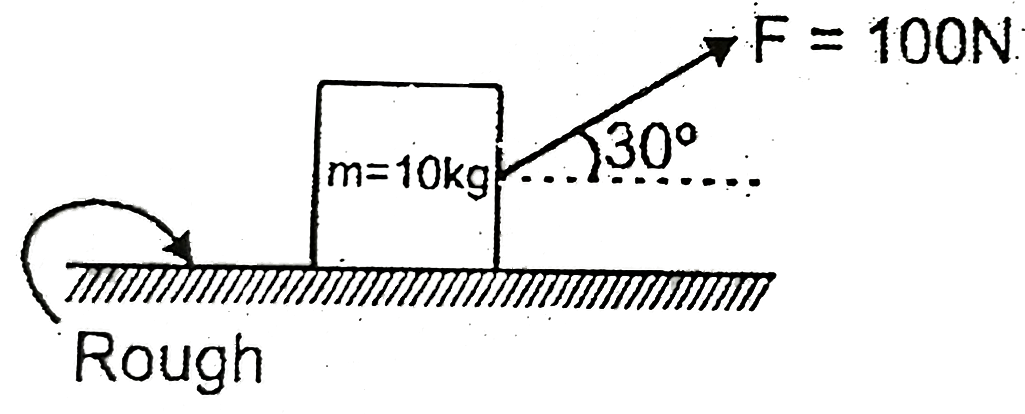A block of weight 9.8N is placed on a table. The table surface exerts an upward force of 10N on the block. Assume g=9.8m/s2.
The block exerts a force of 10N on the table
The block exerts a force of 19.8N on the table
The block exerts a force of 9.8N on the table
The block has an upward acceleration.
The correct Answer is:A, D
From Newtons third law, the force exerted by table on block is equal to that exerted by block on the table. Therefore block exerts a 10N force on table. Since the upward force on the block is larger than downward force, it moves upwards.
Topper's Solved these Questions
- BOOK - RESONANCECHAPTER - DAILY PRACTICE PROBLEMSEXERCISE - dpp 246videos
DAILY PRACTICE PROBLEMS
- BOOK - RESONANCECHAPTER - DAILY PRACTICE PROBLEMSEXERCISE - TRUE/FALSE2videos
DAILY PRACTICE PROBLEMS
- BOOK - RESONANCECHAPTER - DAILY PRACTICE PROBLEMSEXERCISE - dpp 22.8videos
DAILY PRACTICE PROBLEMS
- BOOK - RESONANCECHAPTER - CURRENT ELECTRICITYEXERCISE - Exercise54videos
CURRENT ELECTRICITY
- BOOK - RESONANCECHAPTER - ELASTICITY AND VISCOCITYEXERCISE - Advanced Level Problems9videos
ELASTICITY AND VISCOCITY
Similar Questions
A block of weight 5 units is placed on a horizontal table. A person pushes the block from top by exerting a downward force of 3 units on it. Find the force exerted by the table on the block.
View SolutionA block of mass 10kg is placed on a horizontal surface as shown in the figure and a force F=100N is applied on the block as shown, in the figure. The block is at rest with respect to ground. If the contact force between block and ground is 25n (in Newton) then value of n is : (Takeg=10m/s2)
 View Solution
View Solution
Knowledge Check
- Question 1 - Select One or More
A block of weight 9.8N is placed on a table. The table surface exerts an upward force of 10 N on the block. Assume g=9.8m/s2.
AThe block exerts a force of 10N on the tableBThe block exerts a force of 19.8 N on the tableCThe block exerts a force of 9.8N on the tableDThe block has an upward acceleration - Question 2 - Select One
A block is placed on a horizontal table. Identify the force of action
Aweight of blockBsupport of table on the blockCeither (a) or (b)Dneither (a) nor (b). - Question 3 - Select One
The sides of rectangular plate of mass 20 kg is 5 m x 4 m placed on a horizontal table. The pressure exerted by the block on the table is (Take g=10ms2)
A10 PaB100 PaC20 PaD30 Pa
A block with a weight of 4.0 N is at rest on a horizontal surface A 1.0 N upward force is applied to the block by means of an attached vertical string. What are the (a) magnitude and (b) direction of the force of the block on the horizontal surface ?
View SolutionA block of weight 20 N is placed on a horizontal table and a tension T is applied on the block . Tension can be increased to 8 N before the block begins to slide . A force of 4 N keeps the block moving at constant speed , once it has been set in motion . Find the coefficients of static friction and kinetic friction].
View SolutionA block of mass 2 kg is placed on the floor. The coefficient of static friction is 0.4.A force F of 2.5 N is applied on the block, as shown. Calculate the force of friction between the block and the floor. (g = 9.8 ms–2)
View Solution
In the figure shown, a block of weight 10 N resting on a horizontal surface. The coefficent of static friction between the block and the surface μs=0.4 . A force of 3.5 N will keep the block in uniform motion, once it has been set in motion. A horizontal force force of 3N is applid to the block, then the block willView SolutionA block of mass 3kg is placed on a rough horizontal surface (μs=0.4) . A force of 8.7N is applied on the block. The force of friction between the block and floor is .
View Solution

